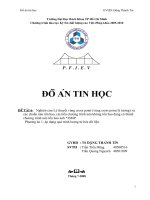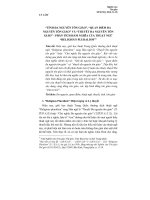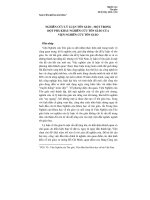Sự tồn tại, duy nhất nghiệm và phương pháp lặp giải một số bài toán biên cho phương trình vi phân phi tuyến
Bạn đang xem bản rút gọn của tài liệu. Xem và tải ngay bản đầy đủ của tài liệu tại đây (1.07 MB, 200 trang )
BỘ GIÁO DỤC VÀ ĐÀO TẠO
VIỆN HÀN LÂM KHOA HỌC
VÀ CÔNG NGHỆ VIỆT NAM
HỌC VIỆN KHOA HỌC VÀ CÔNG NGHỆ
-----------------------------
ĐẶNG QUANG LONG
SỰ TỒN TẠI, DUY NHẤT NGHIỆM
VÀ PHƯƠNG PHÁP LẶP GIẢI MỘT SỐ BÀI TỐN BIÊN
CHO PHƯƠNG TRÌNH VI PHÂN PHI TUYẾN CẤP BA
LUẬN ÁN TIẾN SĨ NGÀNH TOÁN HỌC
HÀ NỘI – 2023
BỘ GIÁO DỤC VÀ ĐÀO TẠO
VIỆN HÀN LÂM KHOA HỌC
VÀ CÔNG NGHỆ VIỆT NAM
HỌC VIỆN KHOA HỌC VÀ CÔNG NGHỆ
-----------------------------
Đặng Quang Long
SỰ TỒN TẠI, DUY NHẤT NGHIỆM
VÀ PHƯƠNG PHÁP LẶP GIẢI MỘT SỐ BÀI TỐN BIÊN
CHO PHƯƠNG TRÌNH VI PHÂN PHI TUYẾN CẤP BA
Chuyên ngành: Toán ứng dụng
Mã số: 9 46 01 12
LUẬN ÁN TIẾN SĨ NGÀNH TOÁN HỌC
NGƯỜI HƯỚNG DẪN KHOA HỌC:
GS.TSKH. Nguyễn Đông Anh
Hà Nội – Năm 2023
VIETNAM ACADEMY OF SCIENCE AND TECHNOLOGY
GRADUATE UNIVERSITY OF SCIENCES AND TECHNOLOGY
THE EXISTENCE, UNIQUENESS AND
ITERATIVE METHODS FOR SOME
NONLINEAR BOUNDARY VALUE PROBLEMS OF
THIRD ORDER DIFFERENTIAL EQUATIONS
by
DANG QUANG LONG
Supervisor: Prof. Dr. NGUYEN DONG ANH
Presented to the Graduate University of Sciences and
Technology in Partial Fulfillment of the Requirements
for the Degree of
DOCTOR OF PHILOSOPHY
HANOI - 2023
DECLARATION OF AUTHORSHIP
I hereby declare that this thesis was carried out by myself under the
guidance and supervision of Prof. Dr. Nguyen Dong Anh. The results in it are
original, genuine and have not been published by any other author. The
numerical experiments performed in MATLAB are honest and precise. The
joint-authored publications have been granted permission to be used in
this thesis by the co-authors.
The author
Dang Quang Long
i
ACKNOWLEDGMENTS
I would like to express my deepest gratitude to my supervisor Prof.
Dr. Nguyen Dong Anh. His immense knowledge and kind guidance have
helped me tremendously in the completion of this thesis.
I would like to show my appreciation to the Graduate University of
Sciences and Technology and Institute of Technology, Vietnam Academy
of Science and Technology for their generous support during the years
of my PhD program.
Last but not least, this thesis would not have been possible without
the support and encouragement from my family, friends and colleagues.
I would like to give a special thanks to my dear father for his invaluable
professional advices.
The author
ii
List of Figures
2.1
2.2
2.3
2.4
2.5
2.6
2.7
2.8
The
The
The
The
The
The
The
The
graph of the approximate solution in
graph of the approximate solution in
graph of the approximate solution in
graph of the approximate solution in
graph of the approximate solution in
graph of the approximate solution in
graph of the approximate solution in
graph of the approximate solution in
Example
Example
Example
Example
Example
Example
Example
Example
2.1.1............24
2.1.2............24
2.1.3...........25
2.1.4............26
2.1.5............28
2.1.6............29
2.2.3............41
2.2.5............43
3.1
3.2
3.3
3.4
3.5
The
The
The
The
The
graph
graph
graph
graph
graph
Example
Example
Example
Example
Example
3.1.3...........53
3.1.4............54
3.2.3............68
3.2.4............69
3.2.5............69
of
of
of
of
of
the
the
the
the
the
approximate
approximate
approximate
approximate
approximate
solution
solution
solution
solution
solution
in
in
in
in
in
4.1 The graph of the approximate solution in Example 4.1.2............80
4.2 The graph of the approximate solution in Example 4.2.2............91
iii
List of Tables
convergence in Example 2.2.1 for TOL = 10−4........................38
convergence in Example 2.2.1 for TOL = 10−6........................38
convergence in Example 2.2.1 for TOL = 10−10.......................39
results in [35] for the problem in Example 2.2.1....................39
convergence in Example 2.2.2 for TOL = 10−4........................40
convergence in Example 2.2.2 for TOL = 10−6........................40
convergence in Example 2.2.2 for TOL = 10−10.......................40
results in [36] for the problem in Example 2.2.2....................40
convergence in Example 2.2.3 for TOL = 10−10.......................41
convergence in Example 2.2.4 for TOL = 10−6........................42
convergence in Example 2.2.5 for TOL = 10−6........................43
3.1 The convergence in Example 3.2.1 for TOL = 10−4........................66
3.2 The convergence in Example 3.2.1 for TOL = 10−5........................66
3.3 The convergence in Example 3.2.1 for TOL = 10−6........................66
3.4 The convergence in Example 3.2.3................................................67
3.5 The convergence in Example 3.2.4................................................68
3.6 The convergence in Example 3.2.5................................................70
2.1 The
2.2 The
2.3 The
2.4 The
2.5 The
2.6 The
2.7 The
2.8 The
2.9 The
2.10The
2.11The
4.1 The convergence
79
4.2 The convergence
10−1079 4.3
The convergence
90
4.4 The convergence
in Example 4.1.1 for stopping criterion ǁUm − uǁ ≤ h2
in Example 4.1.1 for stoppingǁ criterion
−
ǁΦm Φm−1
≤
in Example 4.2.1.
in Example 4.2.3................................................91
iv
Contents
Introduction........................................................1
Chapter 1. Preliminaries..................................................10
1.1. Some fixed point theorems............................................................10
1.1.1...............................................................................................Schaud
er Fixed-Point Theorem.........................................................10
1.1.2...............................................................................................Krasnos
elskii Fixed-Point Theorem....................................................11
1.1.3...............................................................................................Banach
Fixed-Point Theorem.............................................................11
1.2. Green’s functions...........................................................................12
1.3. Some quadrature formulas.................................................................16
Chapter 2. Existence results and iterative method for twopoint third order nonlinear BVPs
.........................................................................
17
2.1. Existence results and continuous iterative method for third order
nonlinear BVPs 17
2.1.1...............................................................................................Introdu
ction.......................................................................................17
2.1.2...............................................................................................Existen
ce results...............................................................................18
2.1.3...............................................................................................Iterativ
e method................................................................................21
2.1.4...............................................................................................Some
particular cases and examples..............................................22
2.1.5...............................................................................................Conclus
ion..........................................................................................30
2.2. Numerical methods for third order nonlinear BVPs......................31
2.2.1...............................................................................................Introdu
ction.......................................................................................31
2.2.2...............................................................................................Discret
e iterative method 1..............................................................32
2.2.3...............................................................................................Discret
e iterative method 2..............................................................35
2.2.4...............................................................................................Exampl
es...........................................................................................37
2.2.5...............................................................................................On
some extensions of the problem............................................42
2.2.6...............................................................................................Conclus
v
ion..........................................................................................44
Chapter 3. Existence results and iterative method for some
nonlinear ODEs with integral boundary conditions
............................................................................
45
3.1. Existence results and iterative method for fully third order
nonlinear integral boundary value problems
45
3.1.1...............................................................................................Introdu
ction.......................................................................................45
3.1.2...............................................................................................Existen
ce results...............................................................................45
3.1.3...............................................................................................Iterativ
e method................................................................................51
3.1.4...............................................................................................Exampl
es...........................................................................................52
3.1.5...............................................................................................Conclus
ion..........................................................................................54
3.2. Existence results and iterative method for fully fourth order
nonlinear integral boundary value problems
55
3.2.1...............................................................................................Introdu
ction.......................................................................................55
3.2.2...............................................................................................Existen
ce results...............................................................................56
3.2.3...............................................................................................Iterativ
e method on continuous level................................................61
3.2.4...............................................................................................Discret
e iterative method.................................................................62
3.2.5...............................................................................................Exampl
es...........................................................................................65
3.2.6...............................................................................................Conclus
ion..........................................................................................70
Chapter 4. Existence results and iterative method for integrodifferential and functional differential equations
............................................................................
71
4.1. Existence results and iterative method for integro-differential equation
71
4.1.1...............................................................................................Introdu
ction.......................................................................................71
4.1.2...............................................................................................Existen
ce results...............................................................................71
4.1.3...............................................................................................Numeri
cal method.............................................................................74
4.1.4...............................................................................................Exampl
es...........................................................................................78
vi
4.1.5...............................................................................................Conclus
ion..........................................................................................80
4.2. Existence results and iterative method for functional differential
equation. 81 4.2.1. Introduction
81
4.2.2...............................................................................................Existen
ce and uniqueness of solution...............................................81
4.2.3...............................................................................................Solutio
n method and its convergence..............................................84
4.2.4...............................................................................................Exampl
es...........................................................................................89
4.2.5...............................................................................................Conclus
ion..........................................................................................91
General Conclusions..............................................92
List of works of the author related to the thesis. . .93
References.........................................................94
vi
i
Introduction
Overview of research situation and the
necessity of the re- search
Numerous problems in the fields of mechanics, physics, biology,
environment, etc. are reduced to boundary value problems for high
order nonlinear ordinary differential equations (ODE), integro-differential
equations (IDE) and functional differential equa- tions (FDE). The study of
qualitative aspects of these problems such as the existence, uniqueness
and properties of solutions, and the methods for finding the solutions
al- ways are of interests of mathematicians and engineers. One can find
exact solutions of the problems in a very small number of special cases.
In general, one needs to seek their approximations by approximate
methods, mainly numerical methods. Below we review some important
topics in the above field of nonlinear boundary value problems and
justify why we select problems for studying in this thesis.
a) Existence of solutions and numerical methods for twopoint third order nonlinear boundary value problems
High order differential equations, especially third order and fourth
order differen- tial equations describe many problems of mechanics,
physics and engineering such as bending of beams, heat conduction,
underground water flow, thermoelasticity, plasma physics and so on [1, 2,
3, 4]. The study of qualitative aspects and solution methods for linear
problems, when the equations and boundary conditions are linear, is
basically re- solved. In recent years, ones draw a great attention to
nonlinear differential equations. There are numerous researches on the
existence and solution methods for fourth order nonlinear boundary
value problems. It is worthy to mention some typical works con- cerning
the existence of solutions and positive solutions, the multiplicity of
solutions, and analytical and numerical methods for finding solutions
[5, 6, 7, 8, 9, 10]. Among the contributions to the study of fourth order
nonlinear boundary value problems, there are some results of
Vietnamese authors (see, e.g., [11, 12, 13, 14]).
Concerning the not fully or fully third order differential equations
uJJJ (t) = f (t, u(t), uJ (t), uJJ (t)), 0 < t < 1
(0.0.1)
there are also many researches. A number of works are devoted to the
existence, unique- ness and positivity of solutions of the problems with
different boundary conditions. The methods for investigating qualitative
aspects of the problems are diverse, including the method of lower and
upper solutions and monotone technique [7, 15, 16, 17, 18, 19], Leray×
→
1
Schauder continuation principle [20], fixed point theory on cones [21],
etc. It should be emphasized that in the above works there is an
essential assumption that the function f (t, x, y, z) : [0, 1] R3 R satisfies a
Nagumo-type condition on the last two variables [22], or linear growth
in x, y, z at infinity [20], or some complicated conditions including
monotone increase in each of x and y [23], or one-sided Lipschitz
2
condition in x for f = f (t, x) [19] and in x, y for f = f (t, x, y) [17]. Sun et
al. in [24] studied the existence of monotone positive solution of the
BVP for the case f = f (u(t)) under conditions which are difficult to be
verified.
Differently from the above approaches to the third order boundary
value problems, very recently Kelevedjiev and Todorov [25] using barrier
strips type conditions gave suf- ficient conditions guaranteeing positive or
non-negative, monotone, convex or concave solutions.
It should be said that in the mentioned works, no examples of
solutions are shown although the sufficient conditions are satisfied
and the verification of them is difficult. Therefore, it is desired to
overcome the above shortcoming, namely, to construct easily verified
sufficient conditions and show examples when these conditions are
satisfied and solutions in these examples.
For solving third order linear and nonlinear boundary value
problems for the equa- tion (0.0.1) having in mind that the problems
under consideration have solutions, there is a great number of methods
including analytical and numerical methods. Below we briefly review
these methods via some typical works. First we mention some works
where analytical methods are used. Specifically, in [26] the authors
proposed an it- erative method based on embedding Green’s functions
into well-known fixed point iterations, including Picard’s and
Krasnoselskii–Mann’s schemes. The uniform con- vergence is proved
but the method is very difficult to realize because it requires to
calculate integrals of the product the Green function of the problem
with the func- tion f (t, un (t), uJn (t), uJnJ (t)) at each iteration. In [27, 28]
the Adomian decomposition method and its modification are applied.
Recently, in 2020, He [29] suggests a simple
but effective way to the third-order ordinary differential equations by
the Taylor series technique. In general, for solving the BVPs for
nonlinear third order equations numer- ical methods are widely used.
Namely, Al Said et al. [30] have solved a third order two point BVP
using cubic splines. Noor et al. [31] generated second order method
based on quartic splines. Other authors [32, 33] generated finite
difference schemes using fourth degree B-spline and quintic polynomial
spline for this problem subject to other boundary conditions. El-Danaf
[34] constructed a new spline method based on quartic nonpolynomial
spline functions that has a polynomial part and a trigonomet- ric part to
develop numerical methods for a linear differential equation. Recently,
in 2016 Pandey [35] solved the problem for the case f = f (t, u) by the
use of quartic polynomial splines. The convergence of the method of at
least O(h2) for the linear case f = f (t) was proved. In the following
year, this author in [36] proposed two
difference schemes for the general case f = f (t, u(t), uJ (t), uJJ (t)) and
also established the second order accuracy for the linear case. In
2019, Chaurasia et al. [37] used exponential amalgamation of cubic spline functions to form a novel
numerical method of second-order accuracy. It should be emphasized
that all of above mentioned authors only drew attention to the
construction of the discrete analogue of the equation (0.0.1)
associated with some boundary conditions and estimated the error of
3
the obtained solu- tion assuming that the nonlinear system of
algebraic equations can be solved by known iterative methods. Thus,
they did not take into account the errors arising in the last iterative
methods.
Motivated by the above facts we wish to construct iterative
numerical methods of competitive accuracy or more accurate compared
with some existing methods, and importantly, to obtain the total error
combining the error of iterative process and the error of discretization
of continuous problems at each iteration.
4
b) Boundary value problems with integral boundary conditions
Recently, boundary value problems for nonlinear differential equations
with integral boundary conditions have attracted attention from many
researchers. They consti- tute a very interesting and important class of
problems because they arise in many applied fields such as heat
conduction,
chemical
engineering,
underground
water
flow,
thermoelasticity and plasma physics. It is worth mentioning some
works concern- ing the problems with integral boundary conditions for
second order equations such as [38, 39, 40, 41, 42, 43]. There are also
many papers devoted to the third order and fourth order equations with
integral boundary conditions.
Below we mention some works concerning the third order nonlinear
equations. The first work we would mention, is of Boucherif et al. [44] in
2009. It is about the problem
uJJJ (t) = f (t, u(t), uJ (t), uJJ (t)), 0 < t <
1, u(0) = 0,
∫
1
uJ (0) − auJJ
(0)
h1 (u(s), uJ (s))ds,
0
=
∫ 1
J
JJ
J
u (1) + (1)
h2(u(s), u
0 (s))ds,
=
bu
where a, b are positive real numbers, f, h1, h2 are continuous functions.
Based on a priori bounds and a fixed point theorem for a sum of two
operators, one a compact operator and the other a contraction, the
authors established the existence of solutions to the problem under
complicated conditions on the functions f, h1, h2. Independently from the
above work, in 2010 Sun and Li [24] considered the problem
uJJJ (t) + f (t, u(t), uJ (t)) = 0, 0 < t < 1,
∫ 1
J
J
u(0) = u (0) = 0, u (1)
=
J
0
g(t)u (t)dt.
By using the Krasnoselskii’s fixed point theorem, some sufficient
conditions are ob- tained for the existence and nonexistence of
monotone positive solutions to the above problem.
Next, in 2012 Guo, Liu and Liang [45] studied the boundary value
problem with second derivative
uJJJ (t) + f (t, u(t), uJJ (t)) = 0, 0 < t < 1,
∫
1
u(0) = uJJ
(0) = 0, u(1)
g(t)u(t)dt.
0
=
The authors obtained sufficient conditions for the existence of positive
solutions by using the fixed point index theory in a cone and spectral
radius of a linear operator. No examples of the functions f and g
satisfying the conditions of existence were shown.
In another paper, in 2013 Guo and Yang [46] considered a problem with
other boundary conditions, namely, the problem
uJJJ (t) = f (t, u(t), uJ (t)), 0 < t < 1,
∫
5
u(0) = uJJ
(0) = 0, u(1)
=
1
0
g(t)u(t)dt.
Based on the Krasnoselskii fixed-point theorem on cone, the authors
established the existence of positive solutions of the problem under
very complicated and artificial growth conditions posed on the
nonlinearity f (t, x, y).
6
Very recently, in [47] Guendouz et al. studied the problem
uJJJ (t) + f (u(t)) = 0, 0 < t < 1,
∫
1
u(0) = uJ (0) = 0, u(1)
g(t)u(t)dt.
=
0
By applying the Krasnoselskii’s fixed point theorem on cones they
established the existence results of positive solutions of the problem.
This technique was used also by Benaicha and Haddouchi in [48] for an
integral boundary problem for a fourth order nonlinear equation.
Many authors also studied fourth order differential equations with
integral
boundary
conditions
(see,
e.g.,
[48,49,50,51,52,53,54,55,56,57,58]). Below we mention only some typical
works. First it is worthy to mention the work of Zhang and Ge [58],
where they studied the problem
uJJJJ (t) = w(t)f (t, u(t), uJJ (t)), 0 < t < 1,
∫ 1
u(0)
g(s)u(s)ds, u(1) = 0,
0
=
∫
1
uJJ (0)
=
0
JJ
h(s)uJJ (s)ds, u (1) = 0,
where w may be singular at t = 0 and/or t = 1, f : [0, 1] R+ R− R+ is
× Using
×
→the fixed point
continuous, and g, h L1[0, 1] are nonnegative.
∈
theorem of cone expansion and compression of norm type, the authors
established the existence and nonexistence of positive solutions.
In 2013, Li et al. [54] studied the fully nonlinear fourth-order
boundary value prob- lem
uJJJJ (t) = f (t, u(t), uJ (t), uJJ (t), uJJJ (t)), t ∈ [0, 1],
∫
J
JJJ
JJ
u(0) = u (1) = (1) = 0, (0)
1
=
u
u
J
JJ
h(s, u(s), u (s), (s))ds,
u
0
where f : [0, 1] R4 R, h : [0, 1] R3 R are continuous functions. Based
× theorem
→
on a fixed point
for a ×
sum →
of two operators, one is completely
continuous and the other is a nonlinear contraction, the authors
established the existence of solutions and monotone positive solutions
for the problem.
Later, in 2015, Lv et al. [55] considered a simplified form of the above
problem
uJJJJ (t) = f (t, u(t), uJ (t), uJJ (t)), t ∈ [0, 1],
∫ 1
u(0) = uJ (1) = JJJ
(1) = 0, (0)
g(s)uJJ (s)ds,
u
JJ
0
u
=
where f : [0, 1] R+ R+ R− R+, g : [0, 1] R+ are continuous functions.
× point
× theorem
×
→ of cone expansion
→
Using the fixed
and compression of
norm type, they obtained the existence and nonexistence of concave
7
monotone positive solutions.
It should be emphasized that in all mentioned above works of
integral boundary value problems the authors could only show
examples of the nonlinear terms satisfying required sufficient
conditions, but no exact solutions are shown. Moreover, the known
results are of purely theoretical character concerning the existence
of solutions but not methods for finding solutions.
8
Therefore, it is needed to give conditions for existence of
solutions, to show exam- ples with solutions, and importantly, to
construct methods for finding the solutions for integral boundary
value problems.
c) Boundary value problems for integro-differential equations
Integro-differential equations are the mathematical models of many
phenomena in physics, biology, hydromechanics, chemistry, etc. In
general, it is impossible to find the exact solutions of the problems
involving these equations, especially when they are nonlinear.
Therefore, many analytical approximation methods and numerical methods
have been developed for these equations (see, e.g. [59, 61, 62, 63, 64,
65, 66, 67, 68, 69]).
Below, we mention some works concerning the solution methods for
integro-differential equations. First, it is worthy to mention the recent
work of Tahernezhad and Jalilian in 2020 [65]. In this work, the authors
consider the second order linear problem
uJJ (x) + p(x)uJ (x) + q(x)u(x) = f (x)
+
u(a) = α, u(b) = β,
∫
a
b
k(x, t)u(t)dt,
a < x < b,
where p(x), q(x), k(x, t) are sufficiently smooth functions.
Using non-polynomial spline functions, namely, the exponential
spline functions, the authors constructed the numerical solution of the
problem and proved that the error of the approximate solution is O(h2),
where h is the grid size on [a, b]. Before [65] there are interesting works
of Chen et al. [60, 69], where the authors used a multiscale Galerkin
method for constructing an approximate solution of the above second
order problem, for which the computed convergence rate is two.
Besides the researches evolving the second order integro-differential
equations, re- cently many authors have been interested in fourth order
integro-differential equations due to their wide applications. We first
mention the work of Singh and Wazwaz [63]. In this work, the authors
developed a technique based on the Adomian decomposition method
with the Green’s function for constructing a series solution of the
nonlinear Voltera equation associated with the Dirichlet boundary
conditions
∫ x
(4)
y (x) = g(x)
k(x, t)f (y(t))dt, 0 < x <
0b,
+
y(0) = α1 , y J (0) = α2 , y(b) = α3 , y J (b) = α4 .
Under some conditions it was proved that the series solution converges
as a geometric progression.
For the linear Fredholm IDE [59]
y (4) (x) + αy JJ (x) + βy(x) ∫ b
−
K(x, t)y(t)dt = f (x), a < x < b,
a
with the above Dirichlet boundary conditions, the difference method
9
and the trape- zoidal rule are used to design the corresponding linear
system of algebraic equations. A new variant called the Modified
Arithmetic Mean iterative method is proposed for solving the latter
system, but the error estimate of the method is not obtained.
The boundary value problem for the nonlinear IDE
y (4) (x) − εy JJ (x)
−
Σ
∫ J 2
.
2
|y (t)| dt y JJ (x) = p(x),
π
π 0
y(0) = 0, y(π) = 0, y JJ (0) = 0, y JJ (π) = 0
10
0 < x < π,









